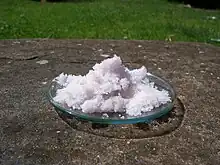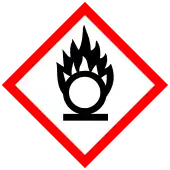6)(NO3)3.svg.png.webp) | |
 | |
| Names | |
|---|---|
| IUPAC name
Iron(III) nitrate | |
| Other names
Ferric nitrate Nitric acid, iron(3+) salt | |
| Identifiers | |
| |
3D model (JSmol) |
|
| ChemSpider | |
| ECHA InfoCard | 100.030.805 |
PubChem CID |
|
| RTECS number |
|
| UNII | |
| |
| |
| Properties | |
| Fe(NO3)3 | |
| Molar mass | 403.999 g/mol (nonahydrate) 241.86 g/mol (anhydrous) |
| Appearance | Pale violet crystals hygroscopic |
| Density | 1.68 g/cm3 (hexahydrate) 1.6429 g/cm3(nonahydrate) |
| Melting point | 47.2 °C (117.0 °F; 320.3 K) (nonahydrate) |
| Boiling point | 125 °C (257 °F; 398 K) (nonahydrate) |
| 150 g/100 mL (hexahydrate) | |
| Solubility | soluble in alcohol, acetone |
| +15,200.0·10−6 cm3/mol | |
| Structure | |
| octahedral | |
| Hazards[1] | |
| GHS labelling: | |
  [2] [2] | |
| Warning | |
| H272, H302, H319 | |
| P210, P220, P221, P264, P270, P280, P301+P312, P305+P351+P338, P330, P337+P313, P370+P378, P501 | |
| NFPA 704 (fire diamond) | |
| Flash point | non-flammable |
| NIOSH (US health exposure limits): | |
REL (Recommended) |
TWA 1 mg/m3[3] |
| Safety data sheet (SDS) | External SDS |
| Related compounds | |
Other anions |
Iron(III) chloride Iron(III) sulfate |
Related compounds |
Iron(II) nitrate |
Except where otherwise noted, data are given for materials in their standard state (at 25 °C [77 °F], 100 kPa).
Infobox references | |
Iron(III) nitrate, or ferric nitrate, is the name used for a series of inorganic compounds with the formula Fe(NO3)3.(H2O)n. Most common is the nonahydrate Fe(NO3)3.(H2O)9. The hydrates are all pale colored, water-soluble paramagnetic salts.
Hydrates
Iron(III) nitrate is deliquescent, and it is commonly found as the nonahydrate Fe(NO3)3·9H2O, which forms colourless to pale violet crystals. This compound is the trinitrate salt of the aquo complex [Fe(H2O)6]3+.[4]
Other hydrates Fe(NO
3)
3·xH
2O, include:
- tetrahydrate (x=4), more precisely triaqua dinitratoiron(III) nitrate monohydrate, [Fe(NO3)2(H2O)3]NO3·H2O, has complex cations wherein Fe3+ is coordinated with two nitrate anions as bidentate ligands and three of the four water molecules, in a pentagonal bipyramid configuration with two water molecules at the poles.[5]
- pentahydrate (x=5), more precisely penta-aqua nitratoiron(III) dinitrate, [Fe(NO3)(H2O)5](NO3)2, in which the Fe3+ ion is coordinated to five water molecules and a unidentate nitrate anion ligand in octahedral configuration.[5]
- hexahydrate (x=6), more precisely hexaaquairon(III) trinitrate, [Fe(H2O)6](NO3)3, where the Fe3+ ion is coordinated to six water molecules in octahedral configuration.[5]
Reactions
Iron(III) nitrate is a useful precursor to other iron compounds because the nitrate is easily removed or decomposed. It is for example, a standard precursor to potassium ferrate K2FeO4.[6]
When dissolved, iron(III) nitrate forms yellow solutions. When this solution is heated to near boiling, nitric acid evaporates and a solid precipitate of iron(III) oxide Fe
2O
3 appears.[7] Another method for producing iron oxides from this nitrate salt involves neutralizing its aqueous solutions.[8]
Preparation
The compound can be prepared by treating iron metal powder with nitric acid, as summarized by the following idealized equation:[9]
- Fe + 4 HNO3 + 7 H2O → Fe(NO3)3(H2O)9 + NO
Applications
Ferric nitrate has no large scale applications. It is a catalyst for the synthesis of sodium amide from a solution of sodium in ammonia:[10]
- 2 NH3 + 2 Na → 2 NaNH2 + H2
Certain clays impregnated with ferric nitrate have been shown to be useful oxidants in organic synthesis. For example, ferric nitrate on Montmorillonite—a reagent called Clayfen—has been employed for the oxidation of alcohols to aldehydes and thiols to disulfides.[11]
Ferric nitrate solutions are used by jewelers and metalsmiths to etch silver and silver alloys.
References
- ↑ HSNO Chemical Classification Information Database, New Zealand Environmental Risk Management Authority, retrieved 2010-09-19.
- ↑ "Iron(III) Nitrate Nonahydrate". American Elements. Retrieved June 20, 2019.
- ↑ NIOSH Pocket Guide to Chemical Hazards. "#0346". National Institute for Occupational Safety and Health (NIOSH).
- ↑ Hair, Neil J.; Beattie, James K. (1977). "Structure of Hexaaquairon(III) Nitrate Trihydrate. Comparison of Iron(II) and Iron(III) Bond Lengths in High-Spin Octahedral Environments". Inorganic Chemistry. 16 (2): 245–250. doi:10.1021/ic50168a006.
- 1 2 3 H. Schmidt, A. Asztalos, F. Bok and W. Voigt (2012): "New Iron(III) Nitrate Hydrates: Fe(NO3|3·xH2O with x = 4, 5 and 6". Acta Crystallographica Section C - Inorganic Compounds, volume C68, pages i29-i33. doi:10.1107/S0108270112015855
- ↑ H. Lux (1963). "Potassium Ferrate (VI) K2FeO4". In G. Brauer (ed.). Handbook of Preparative Inorganic Chemistry, 2nd Ed. Vol. 2. NY, NY: Academic Press. p. 1504.
- ↑ Egon Matijević and Paul Scheiner (1978): "Ferric Hydrous Oxide Sols: III. Preparation of Uniform Particles by Hydrolysis of Fe(III)-Chloride, -Nitrate, and -Perchlorate solutions". Journal of Colloid and Interface Science, volume 63, issue 3, pages 509-524. doi:10.1016/S0021-9797(78)80011-3
- ↑ H. Lux (1963). "Iron (III) Hydroxide FeO(OH)". In G. Brauer (ed.). Handbook of Preparative Inorganic Chemistry, 2nd Ed. Vol. 2. NY, NY: Academic Press. p. 1499.
- ↑ Wildermuth, Egon; Stark, Hans; Friedrich, Gabriele; Ebenhöch, Franz Ludwig; Kühborth, Brigitte; Silver, Jack; Rituper, Rafael. "Iron Compounds". Ullmann's Encyclopedia of Industrial Chemistry. Weinheim: Wiley-VCH. ISBN 978-3527306732.
- ↑ Hampton, K. G.; Harris, T. M.; Hauser, C. R. (1973). "2,4-Nonanedione". Organic Syntheses.; Collective Volume, vol. 5, p. 848 As of 2007, 22 other entries describe similar preparations in Organic Syntheses
- ↑ Cornélis, A. Laszlo, P.; Zettler, M. W. "Iron(III) Nitrate–K10 Montmorillonite Clay" in Encyclopedia of Reagents for Organic Synthesis (Ed: L. Paquette) 2004, J. Wiley & Sons, New York. doi:10.1002/047084289X.
